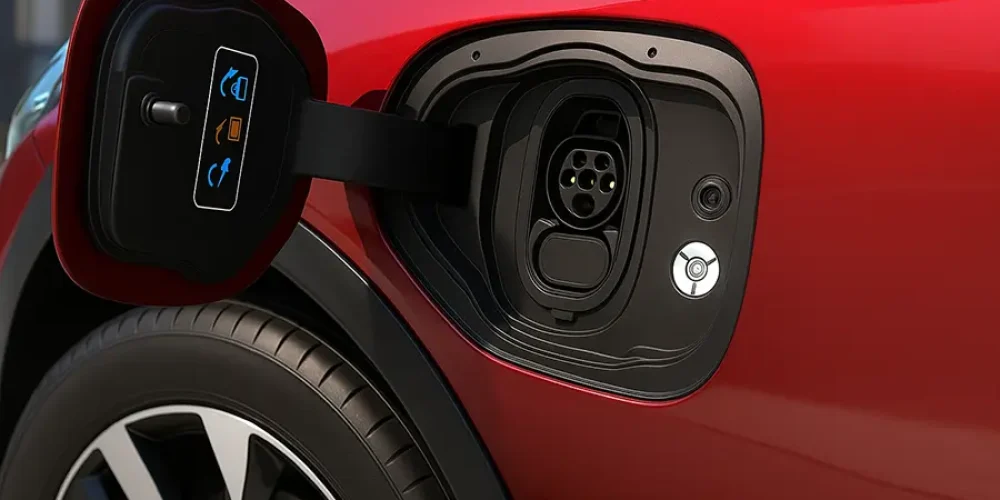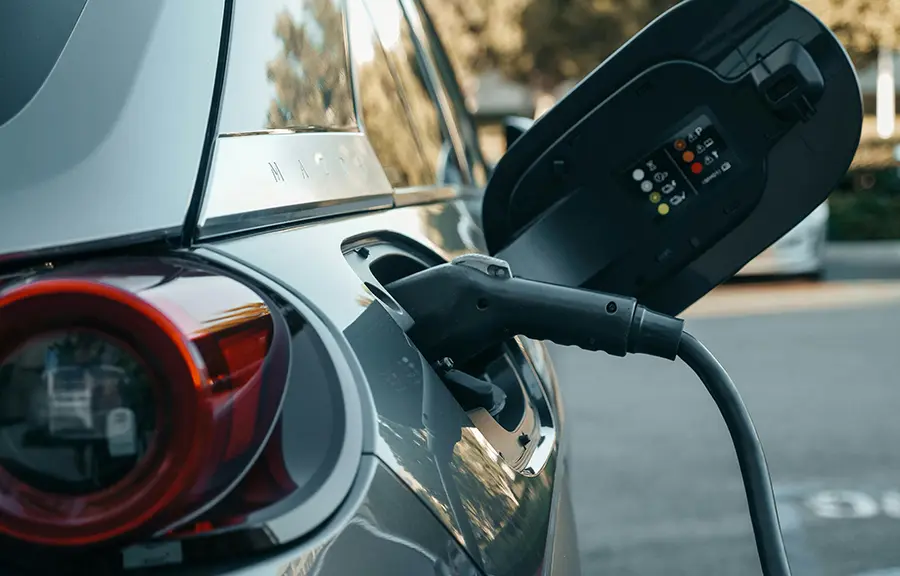
Electric vehicles are only useful if they can charge, right? That sounds obvious. However, early charging infrastructure did not make it easy.
Each region used different connectors. Automakers followed their own standards. Public charging was scattered and inconsistent.
The industry needed one system to fix the mess. And that’s why CCS charging standard exists. Basically, it combines AC and DC charging into one plug. And today, most EVs now rely on it.
If you’re planning to buy an EV, or perhaps just driving one. It would be smart to get familiar with the CCS charging standard. So let’s get into it.
1. What is CCS Charging Standard?

CCS stands for Combined Charging System. The name comes from its ability to handle AC (alternating current) and DC (direct current) both, charging from a single connector. This means you can charge at standard speed at home or rapidly on the road without swapping cables or adapters.
The standard was first developed by a coalition of major automakers and suppliers named CharIN. It launched in the early 2010s and has since become the default for most EVs worldwide, excluding Tesla.
There are two main types:
● CCS1: Used in North America. Combines the standard J1772 AC plug with two DC pins.
● CCS2: Used in Europe and most other markets. Combines the Type 2 AC plug with the same two DC pins.
Both of the versions serve the same purpose, and look very similar.
2. How CCS Charging Works?
The CCS connector is designed with two parts. The top section handles AC charging, whereas the bottom adds two larger pins for DC current. When you plug in a DC fast charger, it bypasses the onboard charger in the car and sends power directly to the battery.
Before charging begins, there’s a “handshake” between the car and charger. The two exchange data about voltage, current limits, and temperature. Once everything checks out, charging starts automatically. There are no manual adjustments required.
Let’s break down how the system handles different situations:
● AC Charging (Level 1 or 2): Power flows through the standard J1772 or Type 2 portion. The car’s onboard charger converts AC to DC.
● DC Fast Charging: Power flows through the two additional DC pins. The charger handles AC to DC conversion externally and sends power straight to the battery.
Power delivery, however, depends on the vehicle and charger.
3. Real World Use and Charging Speeds
You can find CCS charging stations by using apps such as Electrify America, EVgo and others. These apps will provide you with real-time details, and status of charging points. Thereby, making your journey easy to plan.
Speaking of using a CCS charger, it’s quite straightforward. All you do is pull up, plug in, and let the system do the rest. Most public fast chargers include a screen to walk you through the process. Payment is often handled via app, RFID card, or contactless credit card.
Charging time varies. For instance:
● 50 kW charger: Adds around 100 miles (160.93 km) in 30–40 minutes
● 150 kW charger: Adds the same range in 15–20 minutes
● 350 kW charger: Can cut that down to 10 minutes, if your car supports it
Actual speed depends on your car’s state of charge, battery temperature, and peak input capability. Modern EVs do slow down charging above 80% to protect battery health.
Several networks support CCS in the U.S. and Europe. These include but not limited to:
● Electrify America (U.S.)
● EVgo (U.S.)
● Ionity (Europe)
ChargePoint, Shell Recharge, and others
As for EV compatibility, nearly every new electric model outside of Tesla’s ecosystem in North America uses CCS. That includes, for instance, the Ford Mustang Mach-E, Hyundai Ioniq 5, BMW i4, Rivian R1T, and more.
4. Pros and Cons of CCS
Just like any system, CCS has its strengths and compromises.
Pros:
● Dual-function port: Handles standard and fast charging
● Wide adoption: Used by most major automakers, excluding Tesla
● High power support: Supports up to 350 kW
Cons:
● Connector size: Larger and bulkier than Tesla’s NACS plug
● North America compatibility gap: Tesla vehicles use NACS, and several automakers are now transitioning
● Larger plug size: Bulkier than Tesla’s NACS connector
5. CCS Versus Other Charging Standards
Though We’ve have introduction about different charging standard all over the world in the article A Comprehensive Guide to Global EV Charger Standards: CCS, NACS, and GBT, here’s the quick comparison overview:
| Feature | CCS (Combined Charging System) | CHAdeMO | Tesla (NACS) |
|---|---|---|---|
| Charging Speed | Supports DC fast charging from 50 kW up to 350 kW | Typically limited to 50–100 kW | Fast charging up to 250+ kW (higher on newer Superchargers) |
| Adoption | Widely used by most global automakers (non-Tesla) | Mostly used by Japanese brands; declining globally | Standard on all Tesla vehicles; expanding to others via adapters |
| Connector Type | Two versions: Combo 1 (North America) and Combo 2 (Europe) | Single CHAdeMO plug design | Compact, Tesla-exclusive connector (North American Charging Standard) |
| Vehicle Support | Used in EVs from Ford, Hyundai, VW, BMW, Kia, and others | Found mainly on older Nissan and Mitsubishi models | Standard on all Tesla models; adapter support increasing |
| Ease of Use | Common at public chargers; straightforward plug-in process | Requires vehicle-specific adapters in many regions | Simple interface within Tesla’s ecosystem; limited third-party use |
| Future Outlook | Still dominant in Europe and globally; losing ground in the U.S. | Being phased out outside Japan | Rapidly gaining traction in North America with cross-brand support |
As we see, the CCS standard is gaining global adoption due to its versatility but there’s more to it. Let’s take a detailed look.
CCS vs. CHAdeMO
CHAdeMO was one of the earliest DC fast charging systems. It’s used in older models like the Nissan Leaf. But support is fading. Most new EVs do not offer it any longer, and fewer CHAdeMO stations are being built. Power delivery also tops out around 100 kW in most instances.
CCS, by contrast, has higher charging speeds and broader support from automakers and charging networks. It has become the dominant standard in most global markets. However, Japan is the main exception here, where CHAdeMO still remains common due to legacy infrastructure and continued local support.
So, considering the long-term viability, CCS has largely replaced CHAdeMO everywhere else.
CCS vs. NACS (Tesla)
Tesla uses the North American Charging Standard (NACS). Tesla’s Supercharger network has a reputation for reliability and user-friendliness.
For that reason, several automakers are planning to add NACS ports to their EVs starting in 2025. Some are already offering adapters for CCS-equipped vehicles.
NACS is gaining ground specifically in North America. That puts pressure on CCS, but it does not mean it’s going away. Millions of EVs still use CCS, and charging networks will need to support both. For now, CCS and NACS will continue hand in hand, at least for the next several years.
Outside North America, CCS2 remains the dominant standard. And most new EVs globally continue to ship with CCS ports.
For more details of NACS vs CCS especially in the America, you may find in the article: NACS VS CCS : What It Means For EV Owners?
FAQs
What is a CCS charger?
A CCS charger is a charging station that uses the Combined Charging System connector. It supports AC and DC, both charging through a single port.
Which EV is using the CCS charging standard?
As of now, most EVs in the US and Europe, excluding Tesla, are using the CCS charging standard. Some examples are, but not limited to:
● Kia EV6, Niro EV
● Audi Q4 e-tron, e-tron GT
● Volkswagen ID.4, ID.3
● BMW i4, iX, iX1, i5
● Peugeot e-208, e-2008
● And many other brands
In Europe specifically, CCS2 is used on nearly all new EVs from major brands.
Can CCS charging EVs charge at Tesla chargers?
It depends. You can’t just pull up to any Tesla Supercharger. Tesla’s NACS plug does not directly fit CCS ports. That being said, some brands now support NACS and offer adapters. However, that only works at Tesla sites that are open to non-Tesla vehicles. The adapter alone is not enough. A few Superchargers in the U.S. include a built-in adapter called Magic Dock. That lets CCS-equipped EVs plug in without bringing anything extra. But coverage is still limited. Support also depends on location. You may need to use the Tesla app to start the session. Always check charger compatibility in your app before you go.
Can I use the j1772 adapter on the CCS charger?
No, you can not use a J1772 adapter on a CCS charger, because it is used when you need to charger under level 1 or level 2. You may need to charge your non-tesla EVs by a tesla charger by using a tesla to J1772 adapter; and you may need to charger your tesla EV by a J1772 charger by using a J1772 to tesla adapter.
Does NACS to CCS adapter lessen charging speed?
No, the adapter itself does not bottleneck charging speed. It’s just a physical bridge between two plug types. It does not limit power on its own.
However, charging speed still depends on:
– Your vehicle’s max DC input
– The charger’s output
– Whether the adapter supports full power (eg. up to 250 kW)
Furthermore, Tesla Superchargers are not fully optimized for CCS vehicles yet. If you see slower speeds, that could be why.
It is also advised to use a high-quality, certified adapter to avoid compatibility or heating issues.
